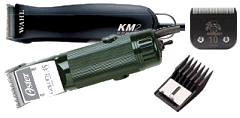-
Different clippers are designed to clip different types of hair-coats. Heavily coated breeds or dogs whose coat is matted or heavily tangled require stronger, better quality clippers than light coated breeds.
-
The faster a blade moves, the easier and faster it will cut. Better quality clippers have faster motors.
How fast a blade moves is dictated by the quality and strength of the motor in the clippers as well as how well you lubricate the blade while you clip. Kool Lube lubricates your blade as you clip to keep its movement free and unimpeded.
-
When a blade is moving, friction creates heat which makes the blade get hot. Test the blade against your cheek or the inside of your forearm (like a baby bottle) to be sure it isn't uncomfortably hot for your pet. Kool Lube keeps your blade cool.
-
Different blades leave different lengths of hair. The lower the blade number, the longer the hair ie: a #4F blade leaves 5/8" of hair and a #10 leaves only 1/16" of hair. ie: The #10 is used for smooth or summer cuts, the #4F for "fuzzy" cuts.
-
Skip Tooth blades cut faster through dense, matted hair, but their clip is rough and not attractive. Use a skip tooth blade for the first pass "rough in" and then smooth your grooming with a full tooth blade.
-
Smooth faces, feet, the pads of the feet, groin and tummy areas and anal areas can usually be clipped very close with a #10, #15, or lightly with a #30 or #40 blade to clean them of hair.
-
Never clip a dirty dog. Dirt and products such as flea powders destroy the cutting surface of your blade.
-
Never clip a wet dog. It's too hard to get through the coat.
-
Clipping AGAINST the hair growth pattern leaves shorter hair than clipping WITH the hair growth.
-
Store your blade clean, coated with Kool Lube, wrapped in a paper towel and enclosed in a plastic, air-tight baggie to prevent corrosion from humidity on the cutting surfaces.
-
Attachment Comb
must be over #40 blade.
-
"or"
(ex. #10 or #15) - Select the blade according to how long you
want to leave the coat.
-
"&"
(ex. #7 & #7FC) - Use the "skip tooth" (ie. #7)
blade before bathing and the "finish cut" (ie. #7FC)
blade after bathing to complete the cut.
-
Blade cutting
lengths listed (refer to Blade Chart) are against natural lie
of the coat. Cutting with lie of the coat leaves hair one size
longer (ex. #7 cut with lie of the coat = length of #5).
-
Andis AG blades
will fit on the Andis model AG, AG-2, AGR and MBG Clippers and
Oster A5 Clipper.
-
DO NOT use skip
tooth blades on cats.
-
Keep skin taut when
clipping dogs and cats.
